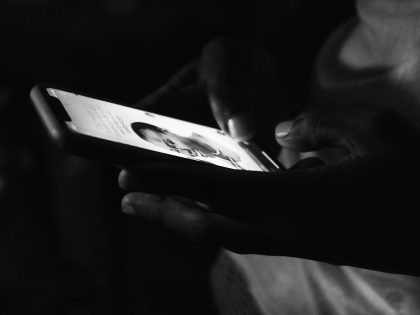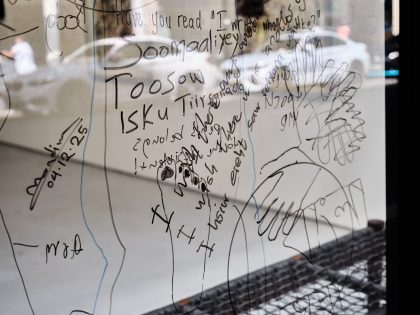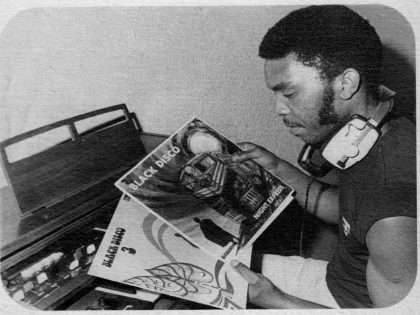Whip it Good
The Danish-Trinidadian artist Jeanette Ehlers is using the white man’s tools to strike back.

Jeannette Ehlers, "Whip it Good," 2015 performance at Rivington Place. Photo: Zoe Maxwell.
Jeannette Ehlers’ ‘Whip it Good’ seeks to create poetry between aesthetics and the brutality of the creation of an artwork with a whip. The performance consists of a white canvas, a whip rubbed in charcoal and an audience. Her timely and poignant work deals with power structures in society through an interactive performance art piece. Danish-Trinidadian artist Ehlers uses the white canvas as a representation of hegemonic whiteness and juxtapositions this with the use of white body paint and dress from Haitian and African cultures. Her work, commissioned in 2013 by Alanna Lockward (read about Lockward’s work here and here), speaks to broader narratives of slavery, colonialism and gender. Rivington Place in London is hosting Ehlers’ first solo show in the United Kingdom, kicked off by seven days of performing and followed by a seven-week exhibition.
On the last night of the performance, Rivington Place is packed. There is a permeable tension in the gallery when Ehlers picks up the whip and strikes it against the canvas over and over again. After about ten minutes in she asks the audience to please finish the painting. The tension rises. Ehlers looks around whilst almost summoning people with her look and posture to take over the whip. There is a tangible violence in the repetitive sound of the whip against the white canvas. Every time the whip strikes the canvas hard there is a visceral reaction from both the audience as well as the artist. There is no telling who will stand up and whip the canvas next. The silence in between is powerful and creates a sense of unknowingness and hyper awareness. In the course of seven days, Ehlers created seven different canvasses all representing different experiences and narratives. The canvasses will be part of the exhibition shown at the gallery represented by Autograph ABP.
Ehler in conversation with guest curator Karen Alexander explains in a Q&A, after the final performance, one of the most important experiences of the work lies in who holds the whip. The power dynamics are embedded in who strikes and why. There is a clear difference in a Black woman holding the whip and a white man holding the whip. And there is a different bodily response to a white man taking up the whip. It is here where the complexity of the performance art piece lies. Another complexity lies in the interesting interplay between the aesthetics and poetry of the performance and the sheer violence of the creation of the canvas.
Who strikes back at whom? The artist explains the whip is used to, “strike back with the white men’s tools”. Ehler strikes back in many ways. She strikes back at the violent history of slavery and colonialism. As a Black woman artist she strikes back against the dominance of white male art and patriarchal structures. At the same time, her work stands in solidarity with the continuous violence reenacted against Black lives. Violence from Baltimore to Lampedusa informs her work and makes her angry enough to whip it good. Some days she doesn’t necessarily feel anything, and just is. The participation of the audience in her work tells us something interesting about collective consciousness and its relationship to violence. How aware are we of the legacies of colonial violence? When the performance was conducted in South Africa, no white people would hold the whip. In Denmark, a country with a contested history of slave trade, white people were eager to participate in the performance.
Ultimately, Ehlers work questions how aware we are of the reenactment of continuing colonial violence and how willing or unwilling we are in partaking in the performance of it.



















